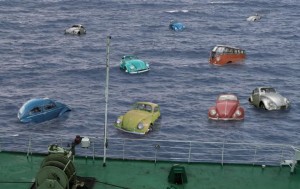
This Week in Motorhead History: Volkswagen Beetles vs the U.S. Navy
by Carl Weyburn
The first Volkwagen Beetle to arrive in the United States was unloaded in New York in 1949, one of just two sold here that year. But by 1964, just 15 years later, Beetles were a ubiquitous sight on US roads and a fleet of 60 cargo ships were bringing more than a quarter-million Bugs to the States each year.
But not all of them got here, and this is the story of the ones that didn’t make it.
Volkswagen owned no ships of its own. While by 1964 most of the ships were outfitted to VWs specifications, they were all chartered, and each returned to Germany carrying coal from West Virginia, which was burned in Volkswagen’s immense factory in Wolfburg. One of these ships was the H.W. Langsdorff, named for the German naval hero who died in 1939.
On an Atlantic crossing from Hamburg to New York in April, 1964, the ship began to take on water due to an explosion and fire in the engine room, which claimed three crew members. The captain put out a distress call, and fortunately for the captain and his surviving crew of 38 men, another Volkswagen charter, the Otto Weddigen, similarly named for a German naval hero, was en route back to Germany and not far away.
The Weddigen was able to rescue the crew of the Langsdorff before the stricken vessel sank into the cold Atlantic, taking its cargo of nearly 1,600 new 1964 VW Beetles with it.
The U.S. Navy also responded to the distress call, dispatching the Stephen Decatur to the scene. The Decatur, a DLG frigate, was the U.S. ship closest to the Langsdorff at the time of the distress call, but further away than the Weddigan. As a result, it arrived when the rescue of the Langsdorff’s crew was complete, but remained there while both ships watched the Langsdorff’s sad sinking.
 Once the Langsdorff slipped under the waves, and once it was confirmed that all of the crew had been rescued (including the bodies of the three seamen who lost their lives in the initial explosion), both the Weddigan and the Decatur were preparing to leave when something happened: A lone VW Beetle popped to the surface.Volkswagens had already begun to attain their reputation as watertight cars, and quickly it became apparent that theLangsdorff had broken apart either as it sank or when it struck the bottom, and that this Beetle had broken free. But then, to the astonishment of the crews of the Weddigan and the Decatur, a second Beetle surfaced. Then a third, and a fourth, and soon a bubbling cascade of Volkswagens, more than 40 in all according to witness accounts, came to the surface.
Once the Langsdorff slipped under the waves, and once it was confirmed that all of the crew had been rescued (including the bodies of the three seamen who lost their lives in the initial explosion), both the Weddigan and the Decatur were preparing to leave when something happened: A lone VW Beetle popped to the surface.Volkswagens had already begun to attain their reputation as watertight cars, and quickly it became apparent that theLangsdorff had broken apart either as it sank or when it struck the bottom, and that this Beetle had broken free. But then, to the astonishment of the crews of the Weddigan and the Decatur, a second Beetle surfaced. Then a third, and a fourth, and soon a bubbling cascade of Volkswagens, more than 40 in all according to witness accounts, came to the surface.
This may seem amusing to us today, but at the time it meant that the Decatur could not leave. The floating Beetles were a serious hazard to navigation in the busy shipping lanes, so the Decatur, protecting international waters, had to stay on scene until it could confirm that every car had sunk.
Some did sink, presumably those that had suffered some damage and filled with water more quickly. But the majority of the cars just floated there, unwilling to go to their watery graves. Faced with the prospect of the cars drifting to who-knows-where in the open sea, the captain of the Decatur issued the order for his men to fire the ship’s guns on the cars.
One by one, nearly three dozen new 1964 Volkswagen Beetles were executed on the high seas by the U.S. Navy. Those cars, and their mechanical brethren trapped in the hull of the Langsdorff, remain at the bottom of the Atlantic to this day. ![]()
April Fool’s, 2016

